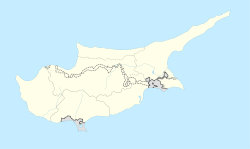Emba (village)
| Empa | |
|---|---|

Panagia Chryseleousa
|
|
| Coordinates: 34°48′N 32°25′E / 34.800°N 32.417°ECoordinates: 34°48′N 32°25′E / 34.800°N 32.417°E | |
| Country |
|
| District | Paphos District |
| Population (2011) | |
| • Total | 4,855 |
Empa (Greek: Έμπα) is one of the largest villages in Paphos, Cyprus. It is spread over a wide area and not only borders Paphos but also the villages of Chlorakas, Kissonerga, Tala, Tremithousa and Mesogi. It has a population of 4,500 people.
The village already existed by the Byzantine era and it is known from the Frankish period with the same name. The 15th century Cypriot historian Leontios Machairas in his Chronicle, par. 129, mentions a visit of the King of Cyprus, Peter I (1359–1369), quoting "...and the king went hunting and reached Emba towards Paphos...".
Louis de Mas Latrie includes the village both amongst those that belonged to the family of the king of Cyprus during the period of Frankish rule, and as one of the king's villages that cultivated sugarcane. During 1468 the village had fallen under the region of Chrysochous, under the regional law officer (bailliage).
The appellation of the village is purely Greek, belonging to the Cypriot dialect. In this dialect Emba means "enter". It is possible that the name of the village was given because it is built at the entrance of Paphos, that is the edges of the city, through which the travellers from the north, northwest and west came in. Another version mentions that the name was given to the village because it is situated near the coast from where people departed from or arrived to Cyprus by sea, during the Byzantine era or even later during the period of Frankish rule. It is mentioned that King Peter I departed for Europe from the area in 1362. The village is noted as 'Emba' in medieval maps.
In the community you can find the ancient church of Panayia Chryseleoussis. Built in the 12th Century in Byzantine Rhythm, it literally embellishes the village square. Almost all the walls in the interior of the church are covered with murals. Certain of them are priceless for their religious and historical value, such as that of Pantokratoros and that of Saint George that are next to the pulpit and which date from around the 13th century. Also to be appreciated is the fretworked gold plated iconostasis from the 16th of century which is adorned with ancient pictures of Jesus, the Virgin Mary and Saint John Precursor. In the church is also found a gospel from the 16th century, which was printed in Venice. Thousands of tourists visit the church each year to admire its architecture and the wonders it contains.
...
Wikipedia

